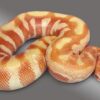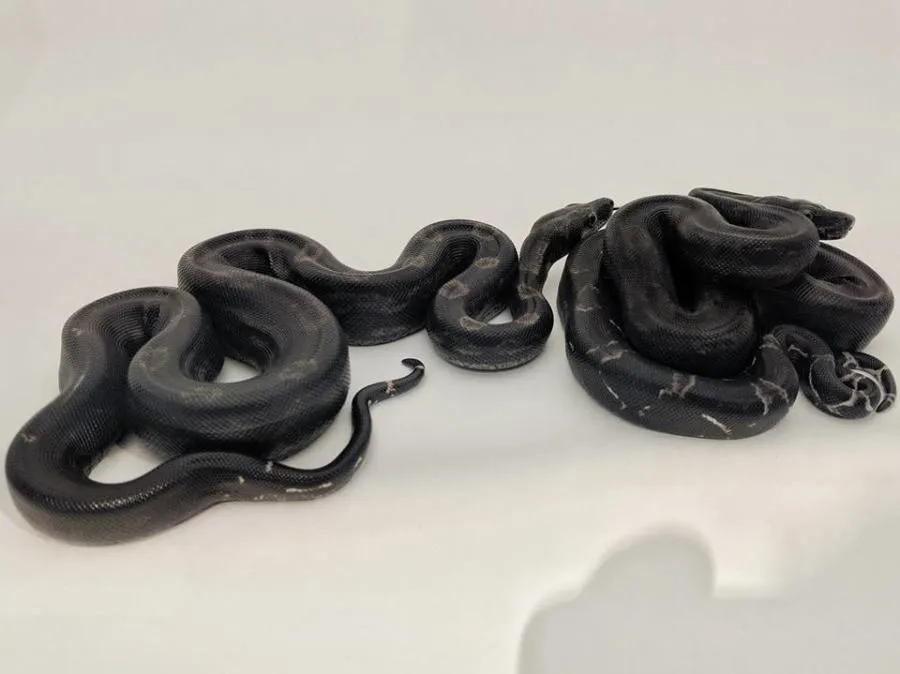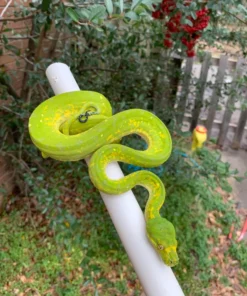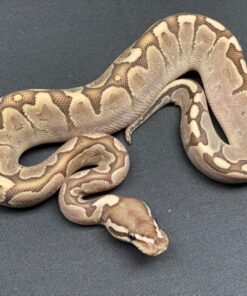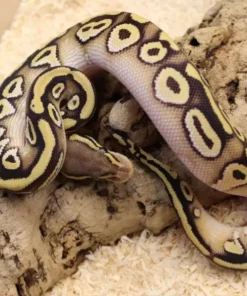$899.00 Original price was: $899.00.$699.00Current price is: $699.00.
Gender: Both Male And Female Available
Weight: Approximately 50-160 grams
Diet: Live and Frozen/Thawed Medium Mice
Image: Representative Image
Breed: Black Devil Boa
Black Devil Boa For Sale
Black Devil Boa for Sale: An In-Depth Guide to This Stunning Reptile
When it comes to exotic reptiles, few creatures captivate the imagination quite like the Black Devil Boa. Known for its striking appearance and fascinating demeanor, this snake is a coveted specimen among enthusiasts. If you’re considering adding a Black Devil Boa to your collection, it’s crucial to understand everything about this unique morph, from its appearance and care requirements to its price and where to find one. This comprehensive guide will cover all aspects of owning a Black Devil Boa, ensuring you have all the information you need before making a purchase.
Understanding the Black Devil Boa
The Black Devil Boa is a morph of the common boa constrictor, characterized by its deep black coloration. This morph is not naturally occurring but has been selectively bred to enhance the dark pigmentation that sets it apart from other boas. The result is a snake that exudes a dramatic and imposing presence, making it a standout addition to any collection.
The Black Devil Boa shares many traits with the standard boa constrictor, including its size, general behavior, and care requirements. However, its unique coloration and the rarity of the morph make it a particularly prized possession among reptile enthusiasts.
Appearance and Morphology
Coloration and Pattern
The defining feature of the Boa is its almost entirely black coloration. Unlike other boa morphs that may have bright colors or intricate patterns, the Boa has a sleek, uniform black appearance. This coloration can range from a deep, matte black to a slightly shinier, almost metallic black, depending on the individual snake and its lineage.
In some specimens, you may notice subtle variations in the black hue, with faint grey or dark brown undertones that add depth to the overall look. These variations are a result of the specific genetic line of the boa and can make each Black Devil Boa unique.
Size and Growth
Boa constrictors, including the Black Devil Boa, are known for their impressive size. In the wild, these snakes can reach lengths of up to 12 feet, although most captive boas typically grow to between 6 and 8 feet. The Black Devil Boa follows this general growth pattern, with males usually being slightly smaller than females.
Juveniles of the Black Devil Boa are smaller and require different care compared to adults. As they grow, their diet and habitat needs will change, so it’s essential to be prepared for their growth and development.
Temperament and Behavior
General Temperament
One of the appealing aspects of the Black Devil Boa is its generally docile temperament. Despite its intimidating appearance, this morph is known for being relatively calm and easy to handle. Boa constrictors, including the Black Devil Boa, are typically less aggressive than some other large snake species, making them suitable for both beginners and experienced reptile keepers.
However, it’s important to note that, like all snakes, the Boa can display defensive behavior if it feels threatened. Proper handling and regular interaction are key to maintaining a good temperament and ensuring the snake remains comfortable with human interaction.
Handling Tips
When handling a Black Devil Boa, it’s crucial to approach with care and respect. Here are some tips for handling:
- Support the Body: Always support the entire body of the snake when handling it. This helps prevent injury and ensures the boa feels secure.
- Move Slowly: Sudden movements can startle the snake. Approach slowly and calmly to avoid causing stress.
- Avoid Handling After Feeding: Wait at least 24-48 hours after feeding before handling your boa to avoid disturbing its digestion.
Regular handling will help your Boa become accustomed to human interaction, making it a more manageable and enjoyable pet.
Housing Requirements
Enclosure Size
As a large snake, the Black Devil Boa requires a spacious enclosure. For adults, a 6 to 8-foot enclosure is recommended. This allows the snake to move around comfortably and provides enough space for essential items such as hides, water bowls, and heat sources.
For juvenile boas, a smaller enclosure can be used initially. However, it’s important to upgrade to a larger space as the snake grows to accommodate its increasing size and provide a suitable living environment.
Substrate and Bedding
The choice of substrate is crucial for maintaining a healthy environment for your Black Devil Boa. Suitable substrates include:
- Cypress Mulch: This substrate is great for maintaining humidity and provides a natural look.
- Aspen Bedding: A good option for easy cleanup and good moisture control.
- Reptile Carpet: Provides a reusable and easy-to-clean surface, but may need additional humidity sources.
Avoid substrates like pine or cedar, which can be harmful to reptiles due to their strong odors and potential for respiratory issues.
Temperature and Heating
Maintaining the correct temperature gradient is essential for the health of your Black Devil Boa. The enclosure should have a warm side and a cool side to allow the snake to regulate its body temperature:
- Warm Side: Maintain temperatures between 85-90°F. Use an under-tank heater or heat lamp to achieve this.
- Cool Side: The cool side should be around 75-80°F. This helps the boa regulate its body temperature and prevents overheating.
A thermostat can help regulate the temperature and ensure it remains consistent. It’s also important to provide a temperature gradient to allow your boa to choose its preferred temperature.
Humidity and Water
Black Devil Boas require moderate to high humidity levels to stay healthy. Aim for a humidity level of 50-60% in the enclosure. This can be achieved through regular misting, a large water bowl, and the use of humidity-retaining substrates.
A large, sturdy water bowl should be provided at all times. This allows the boa to drink and soak if needed, especially during shedding periods. Ensure the water bowl is cleaned regularly to prevent bacterial growth.
Feeding Your Black Devil Boa
Diet
The diet of a Black Devil Boa is similar to other boa constrictors. In the wild, these snakes feed on a variety of prey, including rodents, birds, and small mammals. In captivity, they are usually fed frozen-thawed rats or mice.
Juvenile boas will start with smaller prey, such as fuzzy mice, and gradually progress to larger prey items as they grow. Adult Boas typically eat medium to large rats every 10-14 days.
Feeding Schedule
Establishing a regular feeding schedule is important for the health of your Black Devil Boa. Overfeeding or underfeeding can lead to health problems. Monitor your snake’s weight and adjust the feeding schedule as needed.
It’s also important to provide appropriate-sized prey. The prey should be about as wide as the snake’s body to ensure a proper fit and prevent digestive issues.
Handling and Feeding
Avoid handling your Black Devil Boa immediately after feeding. This can cause stress and disrupt digestion. Allow at least 24-48 hours after feeding before handling the snake.
Health and Veterinary Care
Common Health Issues
Like all reptiles, Boas can be susceptible to certain health issues. Some common problems include:
- Respiratory Infections: Often caused by improper humidity or temperature. Symptoms include wheezing, nasal discharge, and lethargy.
- Mouth Rot (Infectious Stomatitis): Can occur from injuries or poor hygiene. Symptoms include swelling, redness, and discharge in the mouth.
- Parasites: Internal and external parasites can affect boas. Regular veterinary checkups can help detect and prevent these issues.
Regular Checkups
Regular veterinary visits are crucial for maintaining the health of your Black Devil Boa. A reptile-savvy veterinarian can provide routine health checks, address any concerns, and offer advice on keeping your boa in optimal condition.
Breeding Black Devil Boas
Breeding Considerations
Breeding Black Devil Boas is a complex process that requires careful planning and preparation. These boas are live-bearers, meaning they give birth to live young rather than laying eggs. Breeding involves:
- Health and Preparation: Both the male and female should be in excellent health before breeding. Ensure they are well-fed and free of parasites.
- Breeding Season: Boas typically breed during specific seasons. Understanding the breeding cycle and providing the appropriate conditions is essential.
- Gestation and Birth: Female boas can give birth to 10-40 young. Prepare for the birthing process and ensure you have a plan for caring for the newborns.
Breeding boas requires significant knowledge and experience. If you’re interested in breeding, seek advice from experienced breeders and be prepared for the challenges involved.
Black Devil Boa Price
Pricing Factors
The price of a Black Devil Boa can vary significantly based on several factors, including age, sex, and lineage. As a rare and highly sought-after morph, the Black Devil Boa generally commands a higher price than more common boa morphs.
- Juveniles: Typically range from $800 to $1,500. Prices can vary based on the specific traits and quality of the snake.
- Adults: Adult Black Devil Boas may be priced higher, often exceeding $1,500, depending on their lineage and the breeder’s reputation.
- Special Traits: Boas with particularly striking coloration or unique traits may be priced even higher.
When considering the price of a Black Devil Boa, it’s important to balance cost with the quality of the snake and the reputation of the breeder. A higher price may reflect a healthier, well-bred snake with desirable traits.
Finding a Black Devil Boa for Sale
Finding a Black Devil Boa for sale can be challenging due to the rarity of the morph. Reputable breeders and specialized reptile dealers are the best sources for finding this unique snake. Here are some tips for finding a Boa:
- Reputable Breeders: Look for breeders with a strong reputation in the reptile community. They can provide information about the snake’s lineage and health.
- Reptile Shows: Attending reptile shows and expos can provide opportunities to find a Boa and speak with breeders directly.
- Online Marketplaces: Reputable online marketplaces and forums can also be good sources. Ensure that you are purchasing from a trusted seller with positive reviews.
Preparing for Your black devil boa snake
Setting Up the Enclosure
Before bringing your Black Devil Boa home, ensure the enclosure is properly set up. This includes:
- Setting up Heating: Ensure that the enclosure has a proper heating system to maintain the correct temperature gradient.
- Adding Substrate: Choose a suitable substrate and set it up in the enclosure.
- Providing Hides and Water: Ensure there are appropriate hides and a clean water bowl.
Acclimating Your Boa
When you first bring your Boa home, give it time to acclimate to its new environment. Avoid handling the snake immediately to allow it to settle in. Monitor its behavior and ensure it is adjusting well to the new setup.
Conclusion
Owning a Boa is a rewarding experience that requires careful planning and commitment. From understanding its unique appearance and behavior to setting up the perfect habitat and addressing its needs, being well-informed will help ensure a successful and fulfilling experience with this remarkable reptile.
Whether you’re a seasoned boa enthusiast or a newcomer to the world of exotic pets, the Boa offers a unique and captivating addition to your collection. By providing proper care and attention, you’ll enjoy the beauty and intrigue of this extraordinary snake for years to come.
As you embark on the journey of owning a black devil boa snake, remember to seek out reputable sources, stay informed about the best care practices, and prepare for the responsibilities involved. With the right preparation and care, your Boa will thrive and become a cherished part of your reptile family.
| sex | Female, Male |
|---|
Related products
SNAKES

